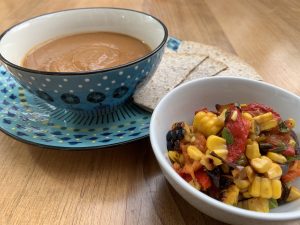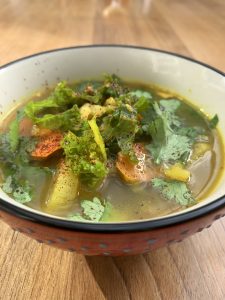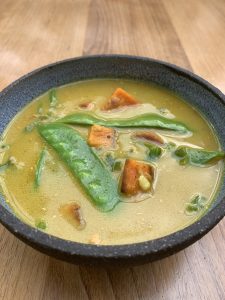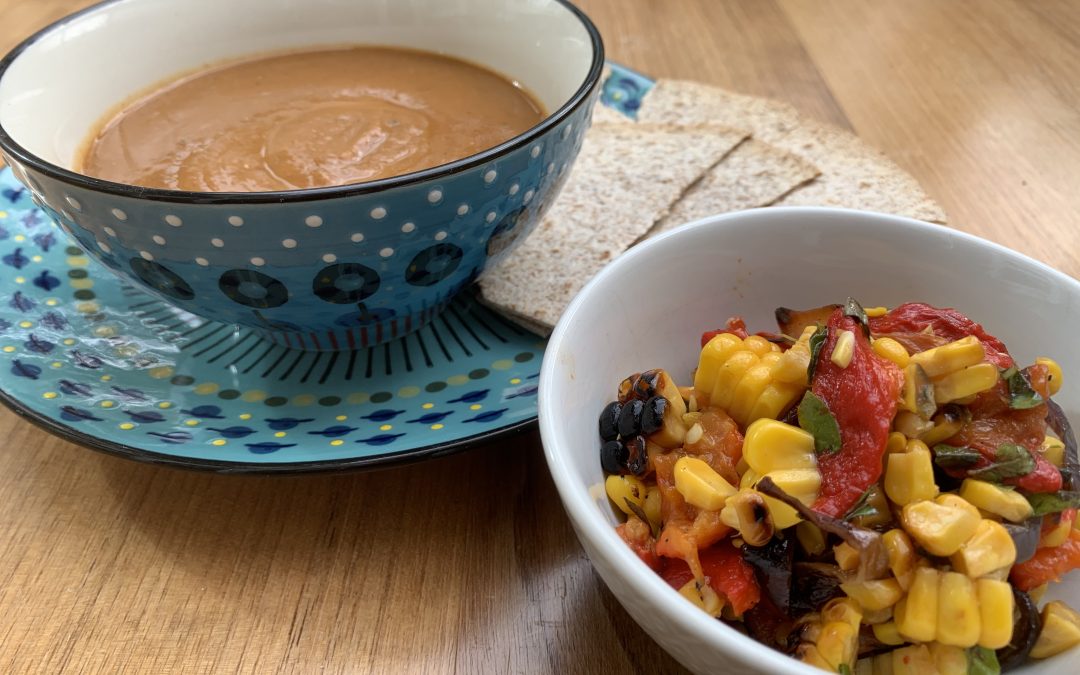When choosing foods to balance the doshas we consider the Gunas (or qualities) of the dosha and the food. You can find out more about he doshas here.
Vata dosha is light, mobile, sometimes erratic, creative, dry and rough. Autumn is Vata season. There is lots of change. Leaves start to become dry and fall from the tree. We feel the moment when from the wind and the temperature drops.
We might feel this physically in our skin, which can become dry, our mind might feel erratic and busy. We might find it difficult to concentrate. Vata dominant people may also feel their digestive system becomes a little out of balance as the colon become dry leading to wind, bloating and constipation.
To bring balance through our diet food should hold the opposite qualities to Vata dosha. Food should be cooked, warming, moist, nourishing and grounding. Vata dosha is balanced by sweet, sour and salty tastes.
This recipe brings all these qualities:
Vata Balancing – Red lentil and roasted red pepper soup.
 Although lentils and pulses have astringent qualities, therefore very drying for Vata, red lentils, which are cooked sufficiently and adding spices to help the digestion, will combat this.
Although lentils and pulses have astringent qualities, therefore very drying for Vata, red lentils, which are cooked sufficiently and adding spices to help the digestion, will combat this.
Ingredients:
- 50g Red lentils
- 2 red peppers roasted in the oven and the skin and seeds removed.
- 1 red onion
- 1tsp Cumin seeds roasted and ground
- 1tsp Coriander seeds roasted and ground
- pinch asafoetida (hing)
- 2 cloves of garlic
- 1 thumb size piece of ginger grated.
- Olive oil or ghee
- Salt and pepper to taste
Heat oil or ghee. Add dry spices and fry for a few minutes. Add chopped onion, garlic and ginger. Fry until onions are soft. Add lentils and continue to fry for another 5 min. add 750mls veg stock and roasted pepper. Simmer until the lentils are soft and cooked thoroughly.
You can blitz it or serve it as it is.
Served here with a roasted pepper salsa on the side. Vata has a tendency towards raw foods. Now is not the time to include raw food in a Vata diet. Roasting corn, pepper and red onion and combining with olive oil, salt, pepper and herbs add a little freshness to the dish. A little flatbread on the side provides a really nourishing meal.
Kapha Balancing Carrot, Kale and Fennel Soup. 
The qualities of Kapha dosha are heavy, sticky, grounded, stable, oily and cold. To maintain balance as we move through Autumn into winter foods should be light, warming (even a little spicy is great to keep the digestive fires of Kapha burning strongly) and somewhat dry. Kapha is balanced by bitter, pungent and astringent tastes.
The light, warming broth and bitter vegetables in this soup is perfect for balancing Kapha. Kapha dosh is prone to heaviness mucus build-up and congestion in the chest. The addition of warming spices and light food can help combat this.
Ingredients:
- 2 carrots – chopped
- A large handful of chopped Kale
- 1 fennel bulb sliced
- 1 onion chopped
- 1 generous lump or ginger grated.
- 3 garlic cloves, grated
- 1/2 tsp ground black pepper or pippali (long pepper)
- 1/2 tsp turmeric
- 750mils Vegetable stock
- Light olive oil.
Heat oil and add spices. Fry for a few minutes. Add garlic and ginger and fry for a minute or 2. Add onions and carrots. Fry for 5 minus then add kale and fennel. Add the warm stock and simmer until all the vegetables are cooked. Light, but warming. Perfect for Kapha. A pinch of chilli flakes or slices of fresh chilli and fresh coriander can be added at the end for a heating kick.
Pitta Balancing Fragrant Coconut and sweet potato soup
 As we have left the heat of summer behind, the Pitta fires burn a little less intensely. Balancing Pitta becomes less of a priority as the energy of Autumn and winter favours Pitta. Pitta dominant people still benefits from wholesome, nourishing, cool foods. Although the Pitta energy is less dominant in our environment, our diet and lifestyle can also lead to imbalance.
As we have left the heat of summer behind, the Pitta fires burn a little less intensely. Balancing Pitta becomes less of a priority as the energy of Autumn and winter favours Pitta. Pitta dominant people still benefits from wholesome, nourishing, cool foods. Although the Pitta energy is less dominant in our environment, our diet and lifestyle can also lead to imbalance.
The qualities of Pitta are hot, oily, penetrating, light and sharp. Tastes which aggravate pitta are pungent, sour and salty, all of which are heating. The diet of Pitta should favour cooling foods with bitter, astringent and sweet tastes.
The addition of coconut in recipes bring a cooling affect, therefore great for Pitta.
Ingredients:
- 1tbs coconut oil
- 1/2 tin coconut milk
- 1 sweet potato. Cubed and roasted in the oven with oil, salt, pepper and ground coriander.
- A handful of kale
- 1/2tsp roasted and ground coriander seeds
- 1/2tsp turmeric powder
- 2 cloves garlic.
- A generous lump of fresh ginger grated.
- 1tbs tamarind paste
- A splash of tamari to taste
- 750mls vegetable stock
Heat he coconut oil and add the dry spices. Fry for a few minutes. Add ginger, garlic and tamarind. Add coconut milk and stock and allow the brith to simmer for 10 mins. Add the sweet potato, kale and season with tamari.
Pitta has a strong appetite and digestive fires. For a more substantial meal serve with rice. Autumn Dosha

